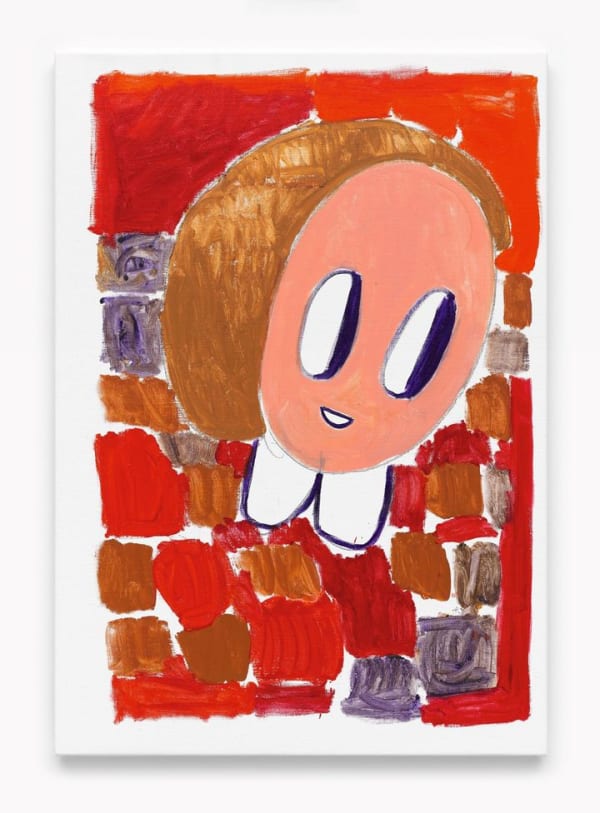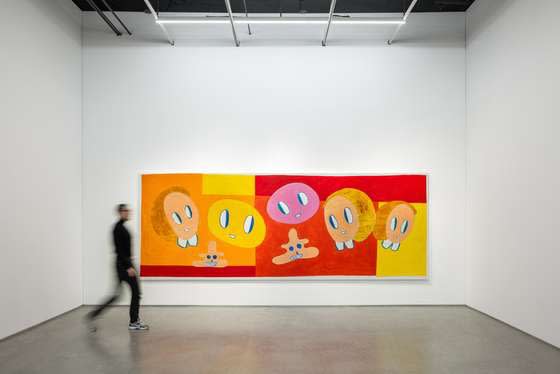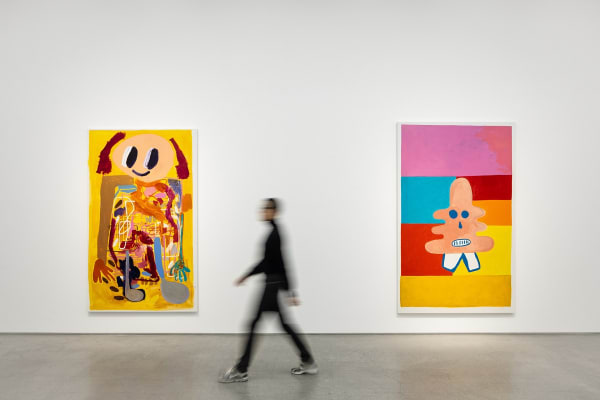ANDRÉ BUTZER Germany, b. 1973
André Butzer (B. 1973, Stuttgart) lives in Berlin-Wannsee. Since the 1990s, André Butzer has been creating his own distinctive language through a fusion of German expressionism and American pop culture, attempting to transcend the artistic, political, and social extremes of the 20th century: life and death, industrialization and mass consumption. At the end of the 20th century, with the end of the Cold War and the sweep of industrialization, Butzer exchanged with artists across generations, to fathom the limitations of artistic thought from the past, and to explore the new possibilities of art.
André Butzer constructs his own methodology, ‘Science-Fiction Expressionism’, as a futuristic descendant of traditional German expressionism. Confronting and embracing extreme realities, the artist used references ranging from corporate names to cartoon characters early in his career to compress 20th-century cultural, political, and technological symbols into distinctively dense paintings. Executed in a rough impasto technique, early works were an effort to translate uncertain hope and desolation into unstable pictorial structures, which he hoped would lead to transcendent truths.
Constantly questioning the existential meaning and the validity of painting, André Butzer has established a body of work with his own unique language. By creating a fictional utopian realm called NASAHEIM, the artist extends his attempts to touch transcendent realms such as color and light, life and death, and truth. A combination of the names of the National Aeronautics and Space Administration (NASA) and the city Anaheim in California, where Disney Land is located, NASAHEIM is an idealized realm that is both farther away than the space and deepest inner of us, where all extremes, longings, joys, and the horrors of history are balanced by reaching equality, and is a key element in understanding the artist's world.
Solo exhibitions of his work have been held in international institutions, including the Friedrichs Foundation, Weidingen (2022); YUZ Museum, Shanghai, and Museum of the Light, Hokuto (both 2020); IKOB Musée d’Art Contemporain, Eupen (2018); Växjö Konsthall (2017); Bayerisches Armeemuseum, Ingolstadt, and Neue Galerie Gladbeck (2016); Kunstverein Reutlingen (2015); Künstlerhaus – Halle für Kunst und Medien, Graz (2014); Kestnergesellschaft, Hanover, and Kunsthistorisches Museum / Theseus tempel, Vienna (2011); Kunsthalle Nuremberg (2009); Kunstverein Ulm (2005) and Kunstverein Heilbronn (2004).
Works by André Butzer are held in the collections of prominent museums including Aurora Museum, Shanghai; Art Institute of Chicago; Carré d’Art, Nîmes; Children’s Museum of the Arts, New York; Contemporary Art Collection of the Federal Republic of Germany, Bonn; Deichtorhallen Hamburg; Faye G. Allen Centre for the Visual Arts, University of Washington, Seattle; Friedrichs Foundation, Weidingen / Bonn; Hall Art Foundation, Reading / VT | Derneburg; Hölderlinturm, Tübingen; IKOB Musée d’Art Contemporain, Eupen; Kupferstichkabinett, Berlin State Museums, Berlin; LACMA Los Angeles County Museum of Art, Los Angeles; Marciano Art Collection, Los Angeles; MARe Museum, Bucharest; MOCA Museum of Contemporary Art, Los Angeles; Museo Nacional Thyssen-Bornemisza, Madrid; Museo Novecento, Florence; Nationalgalerie / Hamburger Bahnhof – Museum für Gegenwart, Berlin; Paula Modersohn-Becker Museum, Bremen; Pinakothek der Moderne, Munich; Rubell Museum, Miami; YUZ Museum, Shanghai, among others.
안드레 부처((b.1973, 슈투트가르트)는 독일 베를린-반제에 거주하며 작업한다. 안드레 부처는 1990년대부터 독일의 표현주의와 미국 대중 문화의 융합을 통해 삶과 죽음, 산업화와 대량 소비 등 20세기의 예술, 정치 및 사회적 극단의 초월을 시도하며 자신만의 독특한 회화 언어를 구축해왔다. 냉전이 종식되고 산업화가 휩쓸고 지나간 20세기 말, 부처는 세대를 뛰어넘어 여러 작가들과 교류를 통해 과거 예술 사조의 한계에 대해 논하며 새로운 예술의 가능성을 탐구했다.
안드레 부처는 독일의 전통적 표현주의의 미래적 후예로 자신만의 회화 양식론 ‘공상과학 표현주의’(Science-Fiction Expressionism)를 구축한다. 극단적인 현실을 직시하고 포용을 시도했던 작가는 작업 초기에 기업 로고부터 디즈니 만화 캐릭터에 이르기까지 다양한 레퍼런스를 활용하여 20세기 문화, 정치, 기술적 상징을 압축시켜 특유의 밀도 높은 작품으로 탄생시켰다. 거친 임파스토 기법으로 완성된 초기 작품들은 불확실한 희망과 황폐함을 불안정한 화면 구조로 옮기려는 노력이었으며 이를 통해 초월적 진실을 이끌어내고자 했다.
안드레 부처는 인간의 실존적 의미와 회화의 유효성에 대해 끊임없이 질문하며, 고유의 회화언어로 자신만의 확고한 작업세계를 구축했다. 작가는 나사하임(NASAHEIM)이라는 가상의 유토피아적 영역을 창조해내어 색과 빛, 삶과 죽음, 진리와 같은 초월적 영역에 닿는 시도를 확장한다. 미국 항공 우주국(NASA)과 디즈니 월드가 위치한 캘리포니아의 도시 애너하임(Anaheim)의 이름을 합성하여 만들어진 나사하임은 우주보다도 멀리 있는 동시에 내면의 가장 깊은 곳에 존재하며 모든 극단, 갈망, 기쁨, 그리고 역사의 공포들이 평등함에 도달하여 균형을 이루는 이상적 영역이며 작가의 작업세계를 이해하는데 주요한 요소가 된다.
대표적인 개인전으로는 티센-보르네미사 미술관(2023), 프리드리히스하펜 쿤스트페어라인 (2023), 프리드리히 재단 (2022), 유즈 뮤지엄, 상하이, 빛의 미술관, 호쿠토 (2020), IKOB 현대미술관, 외펜 (2018), 벡셰 콘스트할, 벡셰 (2017); 바이에른 군 박물관, 잉골슈타트, 노이에 갤러리 글라드베크 (2016), 쿤스트페어라인 로이틀링겐 (2015), 할레 퓌어 쿤스트, 그라츠 (2014), 케스트너게젤샤프트, 하노버, 미술사 박물관, 테세우스 신전, 비엔나 (2011), 쿤스트할레 뉘른베르크(2009), 쿤스트페어라인 울름 (2005), 쿤스트페어라인 하일브론 (2004) 등이 있다.
안드레 부처의 작품은 세계의 유수 기관에 소장 되어 있으며 대표적으로 아이쉬티 재단, 베이루트; 시카고 아트 인스티튜트; 오로라 미술관, 상하이; 까레 다트, 님; 뉴욕 어린이 예술 박물관; CICA 국제 현대미술 센터, 밴쿠버; 독일 연방 공화국 현대미술 컬렉션, 본; 독일 연방 현대미술 컬렉션, 함부르크; 프리드리히 재단, 바이딩겐 / 본; 홀 아트 재단, 레딩 / 버몬트 | 데르네부르크; 횔더린투름, 튀빙겐; IKOB 현대미술관, 유펜; 베를린 동판화 박물관 / 베를린 박물관, 베를린; LACMA 로스앤젤레스 카운티 미술관, 로스앤젤레스; 마르치아노 아트 컬렉션, 로스앤젤레스; 루마니아 현대 미술관, 부쿠레슈티; MOCA 현대미술관, 로스앤젤레스; 노베첸토 미술관, 피렌체; 라인하르트 에른스트 박물관, 비스바덴; 국립갤러리 / 함부르크 반호프 – 현대 미술관, 베를린; 폴라 모더존-베커 박물관, 브레멘; 피나코텍 데어 모데르네, 뮌헨; 루벨 미술관, 마이애미; 괴츠 컬렉션, 뮌헨; 스페이스 K, 서울; 스톨 컬렉션, 뇌르최핑; 인스브루크 페르디난데움 티롤 주립박물관, 인스브루크; 워싱턴 대학교, 시애틀; 유즈 뮤지엄, 상하이 등이 있다.
-
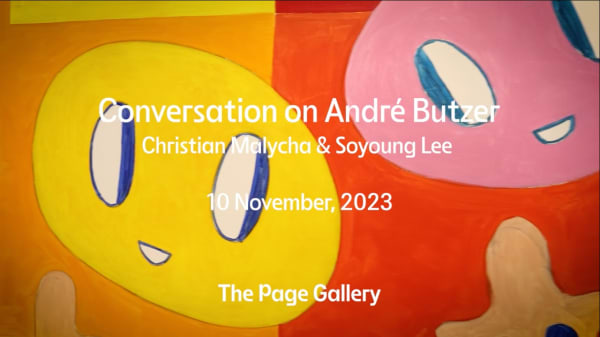
Conversation on André Butzer with Christian Malycha and Soyoung Lee
May 1, 2024The Page Gallery hosted conversations exploring André Butzer's solo exhibition with Christian Malycha and Soyoung Lee on 10 November, 2023.Read more -
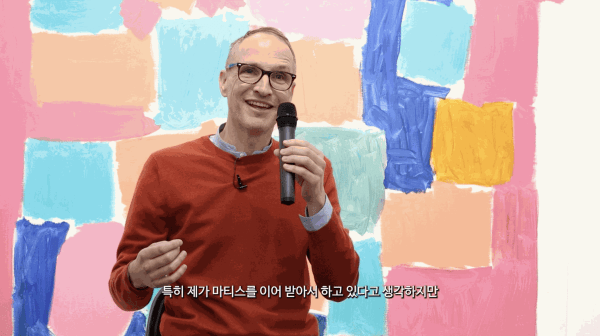
André Butzer
November 25, 2023The Page Gallery is pleased to announce a solo exhibition by German artist André Butzer from November 9 to December 30. This will be the...Read more
-

더페이지갤러리의 평행하고도, 교차하는 나날
W Korea October 2, 2025올해 더페이지갤러리는 프리즈 서울과 키아프 서울 두 페어를 가로지르며 사뭇 서로 다른 얼굴의 부스를 선보였다. 명상과 환희, 고요와 색채가 대비되듯 펼쳐지는 두 부스를 오가며 겹겹이...Read more -

A special feature on André Butzer
SALON - THE INTERNATIONAL ART AND CULTURE MAGAZINE December 24, 2024A special feature on André Butzer has been published in SALON The International Art and Culture Magazine's 86 edition. The SALON Magazine has been introducing...Read more -

안드레 부처가 웃지 않는 이유
VOGUE December 2, 2023더페이지갤러리에서 안드레 부처의 첫 한국 개인전 <André Butzer>가 열렸다. 30년 작가 활동 중 처음이다. 늦은 감이 있지만, 이만큼 적절한 시기도 없다. 올해 50세인 그는 한국에...Read more -
![[문화현장] 앞을 똑바로 쳐다보지 않는 인물들이 이면에 품은 사연은](data:image/gif;base64,R0lGODlhAQABAIAAAAAAAP///yH5BAEAAAAALAAAAAABAAEAAAIBRAA7)
[문화현장] 앞을 똑바로 쳐다보지 않는 인물들이 이면에 품은 사연은
문화경제 November 27, 2023마치 만화 캐릭터처럼 보이는 인물들이 눈에 띈다. 이들은 하나같이 은은한 미소를 짓고 있지만, 자신들을 바라보는 관람객과 절대로 눈을 마주치지 않는다. 이들의 눈동자는 어디를 향하고 무슨...Read more -

겨울 맞아 한국 찾아온 '트리맨'과 '방랑자'
YTN November 18, 2023'공상과학 표현주의' 작가 안드레 부처의 그림엔 외계인 같은 캐릭터들이 등장합니다. 언뜻 보면 알록달록한 색감과 귀여운 이미지이지만 왠지 섬뜩한 느낌을 줍니다. 독일의 어두운 과거사가 숨어 있기...Read more -

독일작가 그림이 이리 사랑스럽다고? 안드레 부처 "마티스에 헌정"
뉴스핌 November 15, 2023독일 베를린을 무대로 활동하는 인기 작가 안드레 부처(50·Andre Butzer)가 한국에서 첫 개인전을 열고 있다. 지난 11월 9일 서울 성수동 더페이지갤러리(대표 성지은)에서 개막해 오는 12월 30일까지...Read more -
![[이주의 전시] 안드레 부처 개인전](data:image/gif;base64,R0lGODlhAQABAIAAAAAAAP///yH5BAEAAAAALAAAAAABAAEAAAIBRAA7)
[이주의 전시] 안드레 부처 개인전
아시아 경제 November 13, 2023더페이지갤러리는 독일 작가 안드레 부처의 개인전을 개최한다. 이번 개인전은 2020년 상하이 유즈 미술관 이후 아시아에서는 3년 만이며 국내에서는 첫 전시다. 전시는 지난 30년간 안드레 부처가...Read more -
![[미술소식] 안드레 부처 첫 국내 개인전](data:image/gif;base64,R0lGODlhAQABAIAAAAAAAP///yH5BAEAAAAALAAAAAABAAEAAAIBRAA7)
[미술소식] 안드레 부처 첫 국내 개인전
연합뉴스 November 12, 2023더페이지 갤러리, 안드레 부처 개인전 = 아트페어 등을 통해 소개된 독일 작가 안드레 부처(50)의 국내 첫 개인전이 서울 성수동 더페이지 갤러리에서 지난 10일 시작했다. 타원형의...Read more -

만화 같은 그림속 '독일 SF표현주의'…안드레부처, 韓 첫 개인전
뉴시스 November 12, 2023박현주 미술전문 기자 = 올 들어 세계 미술계에서 존재감을 확실히 보이고 있는 독일 화가 안드레 부처(50)가 한국에도 상륙했다. 이미 프리즈 키아프 등 아트페어에서 인기몰이를 해온...Read more -

독일 표현주의 작가의 마티스 오마주…안드레 부처 韓 첫 개인전
뉴스1 November 10, 2023독일 작가 안드레 부처의 한국에서의 첫 개인전이 오는 12월30일까지 서울 성동구 더페이지갤러리에서 열린다. 안드레 부처는 1990년대부터 독일의 표현주의와 미국 대중문화의 융합을 통해 삶과 죽음, 산업화와...Read more -

더페이지갤러리, 국내 첫 독일 작가 '안드레 부처' 개인전 열어
미래경제 November 9, 2023더페이지갤러리 이스트관에서 펼쳐지는 이번 전시는 지난 30년 간 안드레 부처가 형성한 작업 세계를 아우르는 주요 신작 15점으로 구성됐다. 안드레 부처는 1990년대부터 독일의 표현주의와 미국 대중문화의...Read more




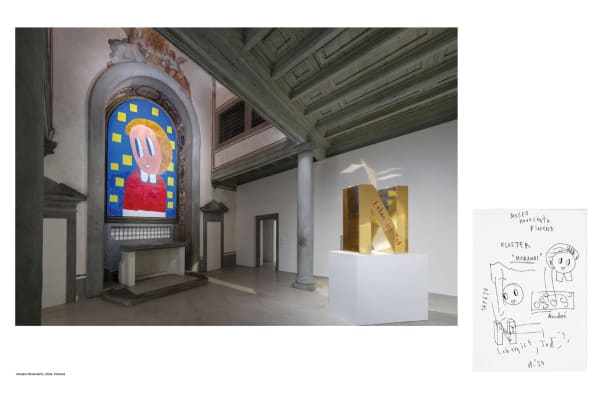

![[문화현장] 앞을 똑바로 쳐다보지 않는 인물들이 이면에 품은 사연은](https://artlogic-res.cloudinary.com/w_600,c_limit,f_auto,fl_lossy,q_auto/ws-artlogicwebsite1534/usr/images/news/main_image/184/_tpg_andre-butzer_005.jpg)
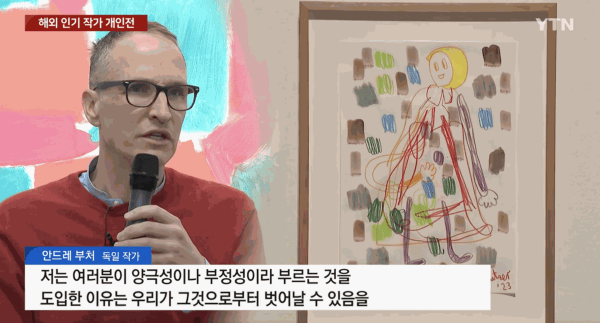
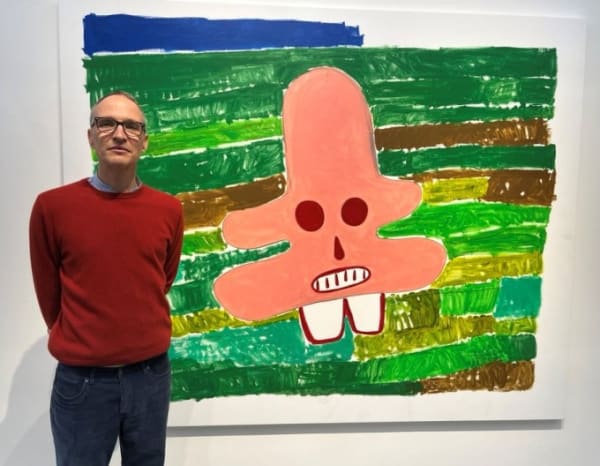
![[이주의 전시] 안드레 부처 개인전](https://artlogic-res.cloudinary.com/w_600,c_limit,f_auto,fl_lossy,q_auto/ws-artlogicwebsite1534/usr/images/news/main_image/179/2023111307350949632_1699828510-1-.jpg)
![[미술소식] 안드레 부처 첫 국내 개인전](https://artlogic-res.cloudinary.com/w_600,c_limit,f_auto,fl_lossy,q_auto/ws-artlogicwebsite1534/usr/images/news/main_image/181/andre-butzer-untitled-2022-acrylic-on-canvas-248-x-199-cm.jpeg)
